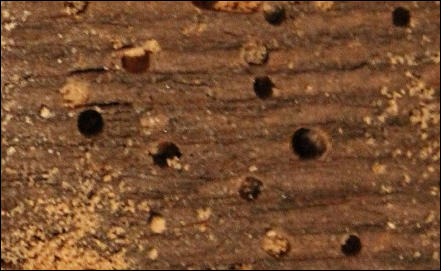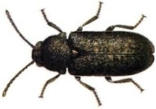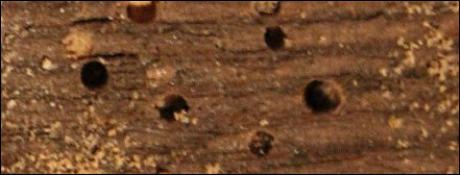Damp Proofing | Damp Proof Course | Ashford | Tunbridge Wells | Canterbury | Tenterden
TimberGuard Timber Preservation
WOODWORM
TimberGuard Timber Preservation offer
guaranteed eradication of woodworm in
Hastings, Ashford, Tunbridge Wells,
Canterbury, Rye and Maidstone.

What is Woodworm?
The term woodworm is a generic term used to
describe a wide variety of wood boring insects, of
which the UK’s most prolific species is the
Common Furniture Beetle (Anobium Punctatum).
Adult Anobium Punctatum do not feed, they just
reproduce, the female laying her eggs in cracks in
the wood. When the eggs hatch around 3 weeks
later, they each produce a creamy white larva
which, for the next 3-5 years will bore through the
timber, consuming the starchy parts of the wood grain. They then move nearer to the wood surface
where they excavate small spaces in readiness for pupation which takes a further eight weeks. The
adults then break through the surface, spilling a cream coloured dust which is the first sign of an
infestation.
If the holes are new, the chances are that many more immature grubs will be tunneling away inside
the wood.
There are are number of other species of wood boring insect which may be present in the timbers of
UK properties and TimberGuard Timber Preservation will identify the type of infestation and apply
the correct treatment.

How is woodworm treated?
A combination of insecticide and wood preservative is pressure sprayed
on to the wood to eradicate the infestation and provide long term
protection against reinfestation. The spray usually also contains
fungicides in order to give additional protection against fungal infections,
such as dry rot. Any structural timbers which may have been weakened by the infection or
infestation will require removal and replacement with sound, pre-treated timber.
Other types of woodworm include:
House Longhorn Beetle (Hylotrupes Bajulus)
Thankfully less common than the furniture beetle, these insects eat through wood at a
prolific rate. The life cycle from egg to adult can be anything from 2 to 10 years
depending on the type, age and quality of the wood and local environmental conditions
such as temperature. Only the larvae actually eat wood but they can consume at such an enormous
rate that sometimes just an outer shell of timber is left. As a result, they can cause significant
structural damage and damaged wood will usually need to be cut out and replaced. The House
Longhorn Beetle is currently found only in the southern Home Counties and is the most damaging
UK wood boring beetle. Adults are most active during the summer months.

Wood Boring Weevil (Pentarthrum huttoni and Euophryum confine)
This insect usually prefers damp wood or wood that is poorly ventilated and so is
often seen in damp cellars, damp wooden floors or loft spaces where there’s a
leaking roof. It will generally attack and follow the softer parts of the timber and so produces tunnels
along the grain of the wood with paper thin walls between. Left untreated, this can result in serious
structural problems.

Death Watch Beetle (Xestobium rufovillosum)
The larvae of the Death Watch Beetle can be present tunneling within the wood
for 5-10 years before emerging to mate. During this time, the amount of wood
consumed can be extensive and the damage done to timbers severe.
The characteristic tapping sound usually associated with this insect is caused by the male beetle
which knocks its head against the wood to attract a mate.

Powder Post Beetle (Lyctus brunneus)
The larvae of this beetle spend months or sometimes years developing inside
wood and timbers and feeding on the starch content. Infestations by this beetle
develop slowly, but wood can be reinfested over many years.
Their presence is usually only apparent when the adults emerge, leaving pin hole sized openings and
piles of powdery dust. The adult beetles are most commonly seen in the summer months but can
appear all year round.

Expert identification of the cause of an infestation and whether or not it is active is important to
avoid inappropriate or unnecessary treatment. An expert assessment of the extent of the damage
done to existing timbers should also be made before treatment.
TimberGuard Timber Preservation will survey your property and provide you with a full report
and a quotation for any necessary repair and treatment work at a cost competitive price plus
the assurance of a 20 year guarantee after the work has been completed.



01233 367155 01892 322165
07312 257516
TimberGuard Timber Preservation
Damp Proofing | Damp Proof Course | Hastings | Ashford
Tunbridge Wells | Canterbury | Rye | Maidstone

WOODWORM
TimberGuard Timber
Preservation offer
guaranteed eradication
of woodworm in Hastings, Ashford,
Tunbridge Wells, Canterbury, Rye and
Maidstone.

What is Woodworm?
The term woodworm is a
generic term used to
describe a wide variety of
wood boring insects, of which the UK’s most
prolific species is the Common Furniture Beetle
(Anobium Punctatum).
Adult Anobium Punctatum do not feed, they just
reproduce, the female laying her eggs in cracks in
the wood. When the eggs hatch around 3 weeks
later, they each produce a creamy white larva
which, for the next 3-5 years will bore through
the timber, consuming the starchy parts of the
wood grain. They then move nearer to the wood
surface where they excavate small spaces in
readiness for pupation which takes a further
eight weeks. The adults then break through the
surface, spilling a cream coloured dust which is
the first sign of an infestation.
If the holes are new, the chances are that many
more immature grubs will be tunneling away
inside the wood.
There are are number of other species of wood
boring insect which may be present in the
timbers of UK properties and TimberGuard
Timber Preservation will identify the type of
infestation and apply the correct treatment.
How is woodworm treated?
A combination of insecticide and wood
preservative is pressure sprayed on to the wood
to eradicate the infestation and provide long
term protection against reinfestation. The spray
usually also contains fungicides in order to give
additional protection against fungal infections,
such as dry rot. Any structural timbers which
may have been weakened by the infection or
infestation will require removal and replacement
with sound, pre-treated timber.
Other types of woodworm include:
House Longhorn Beetle (Hylotrupes Bajulus)
Thankfully less common than the
furniture beetle, these insects eat
through wood at a prolific rate. The
life cycle from egg to adult can be anything from
2 to 10 years depending on the type, age and
quality of the wood and local environmental
conditions such as temperature. Only the larvae
actually eat wood but they can consume at such
an enormous rate that sometimes just an outer
shell of timber is left. As a result, they can cause
significant structural damage and damaged
wood will usually need to be cut out and
replaced. The House Longhorn Beetle is
currently found only in the southern Home
Counties and is the most damaging UK wood
boring beetle. Adults are most active during the
summer months.

Wood Boring Weevil (Pentarthrum huttoni and
Euophryum confine)
This insect usually prefers damp
wood or wood that is poorly
ventilated and so is often seen in damp cellars,
damp wooden floors or loft spaces where there’s
a leaking roof. It will generally attack and follow
the softer parts of the timber and so produces
tunnels along the grain of the wood with paper
thin walls between. Left untreated, this can
result in serious structural problems.

Death Watch Beetle (Xestobium rufovillosum)
The larvae of the Death Watch
Beetle can be present
tunneling within the wood for
5-10 years before emerging to
mate. During this time, the amount of wood
consumed can be extensive and the damage
done to timbers severe.
The characteristic tapping sound usually
associated with this insect is caused by the male
beetle which knocks its head against the wood to
attract a mate.

Powder Post Beetle (Lyctus
brunneus)
The larvae of this beetle spend months or
sometimes years developing inside wood and
timbers and feeding on the starch content.
Infestations by this beetle develop slowly, but
wood can be reinfested over many years.
Their presence is usually only apparent when the
adults emerge, leaving pin hole sized openings
and piles of powdery dust. The adult beetles are
most commonly seen in the summer months but
can appear all year round.

Expert identification of the cause of an
infestation and whether or not it is active is
important to avoid inappropriate or
unnecessary treatment. An expert assessment
of the extent of the damage done to existing
timbers should also be made before treatment.
TimberGuard Timber Preservation will survey
your property and provide you with a full
report and a quotation for any necessary
repair and treatment work at a cost
competitive price plus the assurance of a 20
year guarantee after the work has been
completed.



Ashford Office
Mobile
Tunbridge Wells Office
Timber Treatment | Dry Rot | Woodworm | Hastings | Ashford | Tunbridge Wells | Canterbury | Rye | Maidstone
TimberGuard Timber Preservation
01233 367155 01892 322165
07312 257516
WOODWORM
TimberGuard Timber Preservation offer guaranteed eradication of
woodworm in Hastings, Ashford, Tunbridge Wells, Canterbury, Rye
and Maidstone.

What is Woodworm?
The term woodworm is a generic term used to describe a wide variety of wood
boring insects, of which the UK’s most prolific species is the Common Furniture
Beetle (Anobium Punctatum).
Adult Anobium Punctatum do not feed, they just reproduce, the female laying
her eggs in cracks in the wood. When the eggs hatch around 3 weeks later,
they each produce a creamy white larva which, for the next 3-5 years will bore
through the timber, consuming the starchy parts of the wood grain. They then
move nearer to the wood surface where they excavate small spaces in
readiness for pupation which takes a further eight weeks. The adults then
break through the surface, spilling a cream coloured dust which is the first sign of an infestation.
If the holes are new, the chances are that many more immature grubs will be tunneling away inside the wood.
There are are number of other species of wood boring insect which may be present in the timbers of UK properties and
TimberGuard Timber Preservation will identify the type of infestation and apply the correct treatment.

How is woodworm treated?
A combination of insecticide and wood preservative is pressure sprayed on to the wood to eradicate
the infestation and provide long term protection against reinfestation. The spray usually also
contains fungicides in order to give additional protection against fungal infections, such as dry rot.
Any structural timbers which may have been weakened by the infection or infestation will require
removal and replacement with sound, pre-treated timber.
Other types of woodworm include:
House Longhorn Beetle (Hylotrupes Bajulus)
Thankfully less common than the furniture beetle, these insects eat through wood at a prolific rate. The life cycle
from egg to adult can be anything from 2 to 10 years depending on the type, age and quality of the wood and local
environmental conditions such as temperature. Only the larvae actually eat wood but they can consume at such an enormous
rate that sometimes just an outer shell of timber is left. As a result, they can cause significant structural damage and damaged
wood will usually need to be cut out and replaced. The House Longhorn Beetle is currently found only in the southern Home
Counties and is the most damaging UK wood boring beetle. Adults are most active during the summer months.

Wood Boring Weevil (Pentarthrum huttoni and Euophryum confine)
This insect usually prefers damp wood or wood that is poorly ventilated and so is often seen in damp cellars,
damp wooden floors or loft spaces where there’s a leaking roof. It will generally attack and follow the softer
parts of the timber and so produces tunnels along the grain of the wood with paper thin walls between. Left untreated, this can
result in serious structural problems.

Death Watch Beetle (Xestobium rufovillosum)
The larvae of the Death Watch Beetle can be present tunneling within the wood for 5-10 years before emerging to mate.
During this time, the amount of wood consumed can be extensive and the damage done to timbers severe.
The characteristic tapping sound usually associated with this insect is caused by the male beetle which
knocks its head against the wood to attract a mate.

Powder Post Beetle (Lyctus brunneus)
The larvae of this beetle spend months or sometimes years developing inside wood and timbers and feeding on the starch
content. Infestations by this beetle develop slowly, but wood can be reinfested over many years.
Their presence is usually only apparent when the adults emerge, leaving pin hole sized openings and piles of
powdery dust. The adult beetles are most commonly seen in the summer months but can appear all year round.

Expert identification of the cause of an infestation and whether or not it is active is important to avoid inappropriate or
unnecessary treatment. An expert assessment of the extent of the damage done to existing timbers should also be made
before treatment.
TimberGuard Timber Preservation will survey your property and provide you with a full report and a quotation for any
necessary repair and treatment work at a cost competitive price plus the assurance of a 20 year guarantee after the
work has been completed.














































